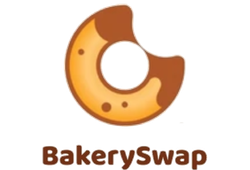
Free Airdrop Season 7 is LIVE! Answer fun questions or do simple tasks to earn rewards from the $30K BitDegree prize pool. Participate Now ! 🔥
Decentralized crypto exchanges (DEXs) are booming these days. It’s not hard to see why: decentralization is, after all, one of the philosophical driving forces behind cryptocurrency, if not the main one. In this Bakeryswap review, I’m going to introduce one of the most popular DEXs of the 2020s crypto scene and explain why you might want to give it a chance!
While centralized crypto exchanges, such as Binance, Bybit, and Kraken, act as mediators between the crypto buyers and sellers, storing their assets and overseeing transactions, decentralized exchanges function more like peer-to-peer marketplaces with no regulatory authority; the power is distributed equally between the users.
Over the years, several prominent DEXs have emerged, but Bakeryswap has become a fan favorite by going the extra mile. On this platform, you can not only swap one coin or token for another but also stake it in a liquidity pool to earn free BAKE tokens, launch your own coins, or buy and sell NFTs on a dedicated marketplace. If any of this piques your interest, get comfy and enjoy this Bakeryswap review.
Verdict at a glance: Bakeryswap is a decentralized crypto exchange that uses the AMM model. It features an NFT marketplace, a token launchpad, and the possibility to earn BAKE tokens by staking them or putting them into the liquidity pool. Unfortunately, it has quite a narrow selection of coins and no customer support.
Pros
- Multiple earning options
- NFT marketplace
- A launchpad for new tokens
- High level of security
Cons
- Limited trading options
- Not very user-friendly
- Not available in the US
Table of Contents
- 1. What is Bakeryswap?
- 2. Bakeryswap Review: PROS
- 2.1. Multiple Ways to Trade and Earn Crypto
- 2.2. NFT Marketplace
- 2.3. Robust Security
- 2.4. Cheap and Fast Transactions on BSC
- 3. Bakeryswap Review: CONS
- 3.1. Limited Trading Options
- 3.2. Not Recommended for Beginners
- 3.3. Not Available to US Residents
- 4. Bakeryswap Fees
- 5. How to Use Bakeryswap?
- 6. Conclusions
What is Bakeryswap?
This Bakeryswap review would best be served with some introductory background first, wouldn’t you say?
This platform is an open-source decentralized crypto exchange built on the Binance Smart Chain (BSC) network, using the Automated Market Maker (AMM) protocol. Rather than relying on traders to manually maintain liquidity by encouraging transactions and rewarding "market makers," exchanges with the AMM model invite users to stake their coins in a shared "liquidity pool," which can be accessed as needed[1].
This way, there’s no need for traditional order books or any centralized authority to oversee transactions – users trade with each other directly from their wallets. What’s more, the stakers get rewarded with free BAKE tokens (the platform’s in-house token). This is called “yield farming”. I’m not going to elaborate on this particular feature just yet, though – we’ll get to the Bakeryswap staking review section in a bit!
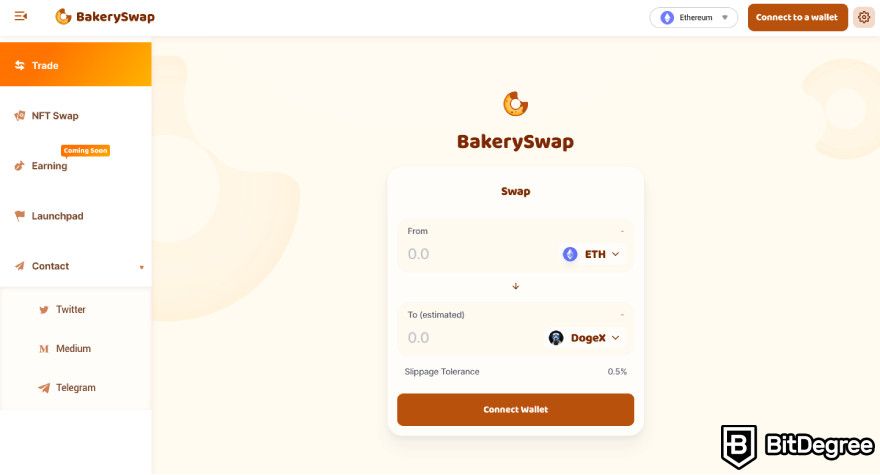
Now that you have an idea what Bakeryswap is, you’re probably curious how it came about in the first place.
Launched in late 2020 by an anonymous team of developers under a decentralized autonomous organization (DAO) structure, this framework allows BAKE token holders—everyone who’s staked their coins in the liquidity pool—to participate in the platform’s governance decisions. This aligns with the DeFi principle of equal power distribution. To the team’s credit, they adhered to this principle consistently, opting not to conduct a BAKE token presale or reserve any tokens for themselves.
To this day, the developers still keep tweaking the platform’s tokenomics and looking for ways to streamline the system. Their end goal is to turn BAKE into a deflationary token so that the exchange doesn’t lose its battle against inflation in the future.
Bakeryswap Review: PROS
Now that I’ve answered the question “What is Bakeryswap?”, it’s time to whip out the scoreboard and fling a few more questions to see how the points add up. Is Bakeryswap safe? How fast is it? What else does it let you do with your crypto besides exchanging it? Read on and find out!
Multiple Ways to Trade and Earn Crypto
Most crypto traders visit exchange platforms with one goal in mind – to buy or sell crypto coins. But that’s not all they’re capable of! If you’re entertaining the idea of using a DEX, I imagine you wouldn’t mind straying off the beaten path. By the end of this Bakeryswap review, you’ll have learned all you need to know about what else you can do with your crypto here.
The centerpiece of the Bakeryswap ecosystem is, of course, the liquidity pool. Until this point, I’ve only mentioned this aspect in passing, but now it’s due for a deeper dive.
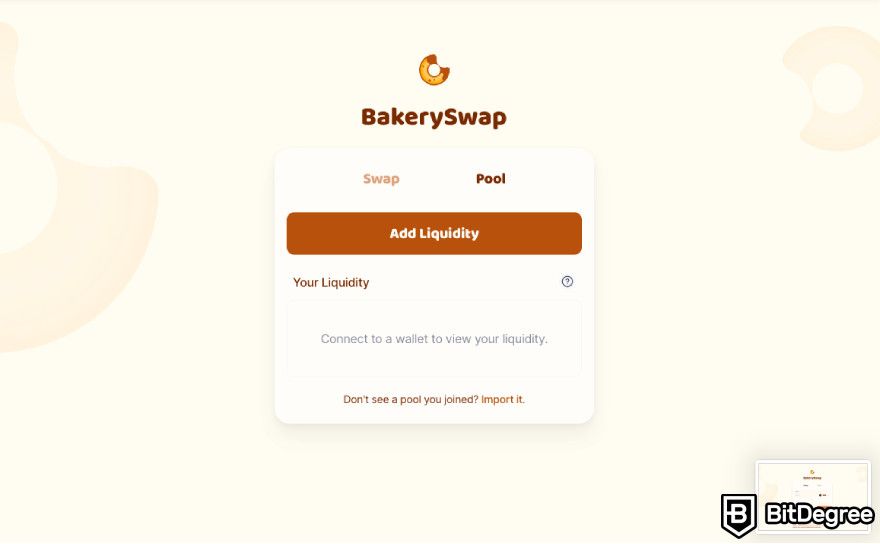
Liquidity pools are a distinguishing feature of DEXs operating under the Automated Market Maker model, such as Bakeryswap. The number one thing any crypto exchange needs to keep itself afloat is liquidity – it can’t function if there’s not enough crypto circulating around, getting in and out of the platform through transactions initiated by traders.
DEXs don’t typically have order books; instead, they facilitate transactions directly between the traders’ wallets in a non-custodial, P2P fashion. This is more akin to swapping coins rather than trading them; that’s why the names of so many DEXs have “swap” in there somewhere.
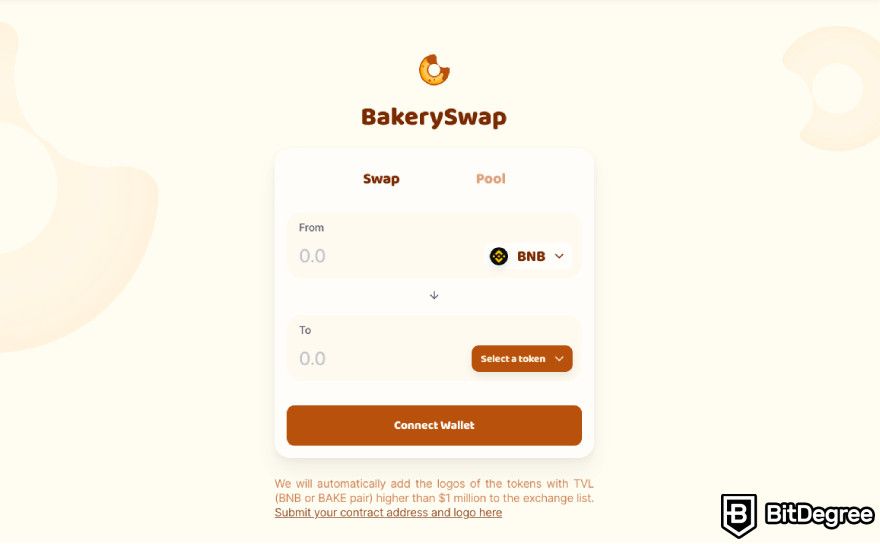
They keep the liquidity up by encouraging users to contribute to a shared crypto pool, to be dipped into whenever a transaction occurs. The pools use smart contracts to automatically calculate the correct amount of crypto to initiate the trade.
What do those good Samaritan users get in return, you ask? What else but the very thing crypto traders want the most – free tokens, of course!
In addition to that, if you’re not content with merely putting your crypto in the liquidity pool and want to squeeze out even more value from your holdings, you can stake your coins, too, and have more BAKE tokens trickle into your wallet as a result.

While the platform understandably pushes BAKE as their flagship token, making it the default option for staking rewards, you receive other limited edition tokens instead, depending on which staking pool you choose. In keeping with the platform’s theme, they’re all named after baked goods. Which is quite fitting, when you think of it – put in the raw ingredients, and you end up with something more than just the sum of its parts!
When it comes to Bakeryswap staking, reviews generally applaud its functionality and value to the traders.
NFT Marketplace
Bakeryswap is far from the first DEX out there, nor is it the first one to implement the Automated Market Maker model. What puts it head and shoulders above some of its competitors, however, is the extensive NFT integration.
At the beginning of my Bakeryswap review, I already brought up the platform’s NFT capabilities, and now it’s time to expand on that particular feature.
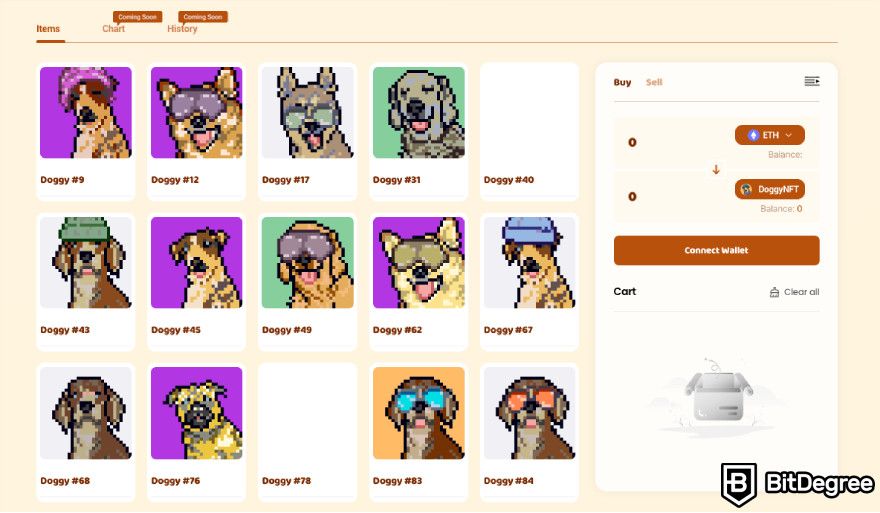
NFTs came out only a few years later than the first cryptocurrency, Bitcoin, did, but they’ve already earned a mainstream position in the crypto sphere. NFT stands for “non-fungible token”: it’s a token that represents a unique digital asset (most often a piece of art or similar content).
The Bakeryswap’s baked-in NFT marketplace makes buying NFTs a breeze – all you have to do is find your pick in the gallery and purchase the desired item, all with just a few clicks! NFTs can be filtered by type (pictures, audio, GIFs, and videos), while the search results are sorted by time, price, and the number of votes each item has.
As of writing this Bakeryswap review, there are over a million NFTs on sale, however – so you’ll probably appreciate the additional categories that make them easier to find. You can filter by featured artists, partner shops, or game assets (the latter featuring digital items like battle weapons or rare cars).

As expected, NFT items are priced in BAKE tokens, and that’s what you’ll have to use to pay for them.
If you’re a creator as well as a consumer – Bakeryswap’s got you covered, too! The marketplace allows users to mint NFTs, as well. All you have to do is fill out the details like file type, name of the artist, and royalties.
Let’s take a little detour down memory lane: at launch, Bakeryswap allowed users to mint NFT “combos”, which were the platform’s first NFTs and could be staked to earn additional BAKE tokens.

Before long, the company removed this feature to maintain the combos' rarity and support their price. However, it soon became clear this wasn’t a smart move – users were vocal about wanting the feature back, and it didn’t take long for the developers to restore the option to mint them.
There are four different combo tiers: basic, regular, luxury, and supreme. They are determined by the number of BAKE tokens used to mint the combo. The higher the tier, the more staking power the combo has.
This wasn’t the only change in the NFT marketplace since its inception, though. One of the more recent adjacent features is the Bakery Gallery – a curated collection of the best NFT artworks. It’s an excellent way for talented up-and-coming artists to gain some exposure and build up a following.
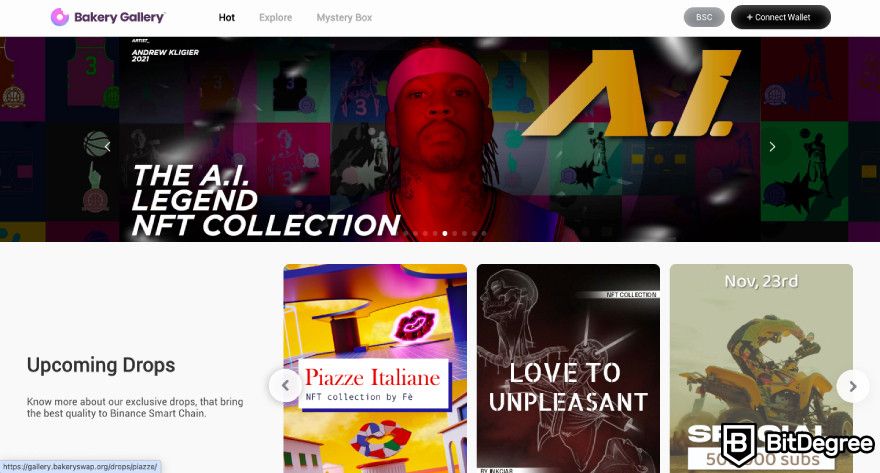
The Bakeryswap Gallery features three main sections:
- Upcoming drops;
- Featured artists;
- Artworks.
The gallery is open for submissions, so if you’ve been looking for an opportunity to showcase your work, simply fill out the form, and one day, you might see your own name and creations in the featured section.
Launch Your Own Tokens
NFTs aren’t the only thing you can create on Bakeryswap – the platform also lets users list their ERC-20 or BEP-20-based crypto. It comes with its very own Launchpad that allows the BAKE token holders to submit their projects for listing. This initiative runs on the Initial Dex Offering (IDO) model, which is often the preferred option for aspiring token creators since it’s seen as more fair and transparent.
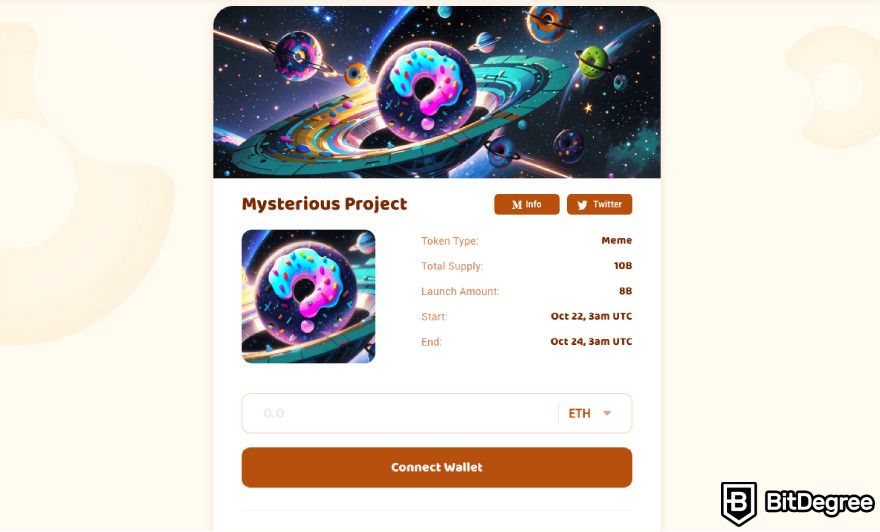
The launched tokens can be purchased using the BUSD stablecoin at a ratio of 100 BAKE to 1 BUSD, meaning that if you hold 100 BAKE tokens, you’re eligible for 1 BUSD worth of new tokens.
Since coming out in 2021, this IDO launchpad has been a resounding success – so much so that Bakeryswap had to tweak the rules and add the condition of a minimum buy-in of 10,000 BUSD to prevent IDOs from reaching the subscription limit too quickly!
Latest Binance Coupon Found:Sign up on Binance and claim up to $600 worth of rewards for completing simple tasks. Use Binance referral code (49316610) to activate the offer while it's still valid!
Robust Security
Everyone has their own level of risk tolerance when it comes to the security of crypto trading. While top centralized exchanges like Binance, Bybit, and Kraken all have a solid security rating, DEXs offer unique security advantages that I’ll explain in this Bakeryswap review.
Time to pose one of the first questions any user should ask when confronted with this (or any other) crypto exchange: “How safe is Bakeryswap?”.
As I’ve already mentioned, the lack of a central intermediary means that clients trade directly with each other using their wallets. Bakeryswap doesn’t own your crypto – you do. This gives exchanges like this a massive edge in resistance to cybersecurity attacks. They’re virtually impossible for hackers to break into!
The servers being spread out rather than concentrated, as they are in centralized exchanges, also reduces the risk of downtime. Even if one of the servers is out of commission, it has little impact on the overall network. With Bakeryswap, you’re unlikely to ever find yourself staring at the dreaded “Error 521” notice on the screen, wondering when your favorite exchange will be up and running again.
Still, you’ll probably be relieved to hear that Bakeryswap doesn’t just coast on the relative imperviousness of its decentralized framework – it takes additional measures to reinforce its security even further. Bakeryswap utilizes smart contract audits to find and neutralize potential vulnerabilities in its code.
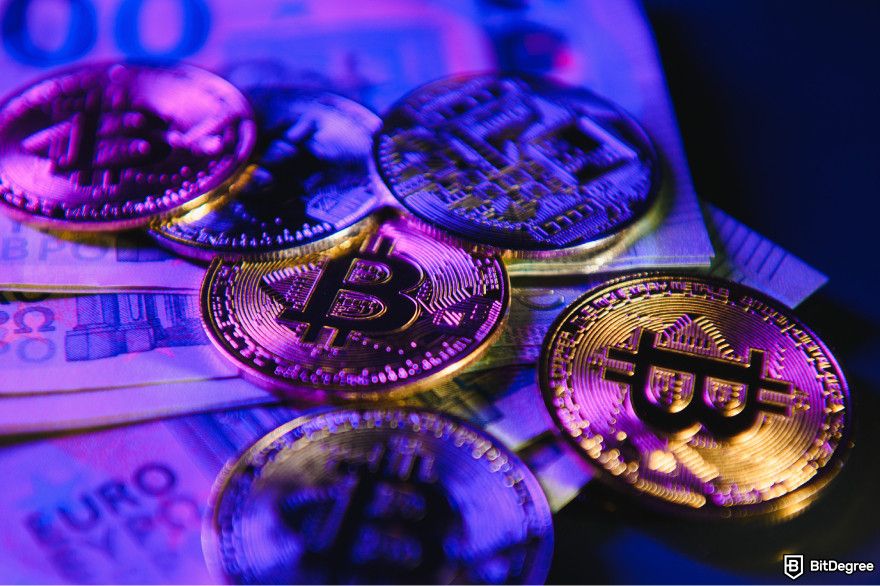
What’s more, the company underwent an audit by CertiK, a renowned Web3 and DeFi platform auditor, and came out with a score of 84.64 out of 100 – which places the exchange in the top 10% of DeFi companies. The score encompasses criteria such as code security, market stability, and operational resilience. However, it bears mentioning that the last audit was carried out in 2020, which may be a tad outdated in such a fast-moving industry.
Another potential drawback is the lack of KYC verification. This isn’t unique to Bakeryswap – decentralized exchanges generally dispense this common security measure, as the very idea of verifying customers’ personal details contradicts the principle of anonymity that DEXs uphold.
On the other hand, the amount of security hoops users have to jump through is inversely proportional to user convenience; some users might appreciate not being subjected to all those pesky document uploads and extra waiting time!
The last security-related concern I feel compelled to comment on is the founders’ anonymity. While it’s not necessarily a problem in itself, and, to be sure, there’s nothing inherently wrong with keeping your identity private – nor does it negate the general impression that Bakeryswap is safe – this has provoked some degree of skepticism among potential investors who’d prefer more transparency.
Cheap and Fast Transactions on BSC
While transactions on centralized exchanges like Binance, Bybit, and Kraken are recorded in an internal database, DEXs operate directly on a blockchain, with transactions managed by the network itself. In this section of my Bakeryswap review, we’ll take a closer look at the technical aspects of the platform’s underlying structure.
DEXs like Bakeryswap have two major decentralized networks to choose from – Ethereum and Binance Smart Chain (BSC). Ethereum is a popular and respected choice; however, it’s often hindered by high gas fees and slower transaction speeds. This has led many DEXs to opt for BSC instead.
BSC was specifically created as an answer to those issues; it enables cheap and blazing-fast transactions for dApps and DeFi projects, lowering the barrier of entry for startups that couldn’t afford Ethereum’s prices.
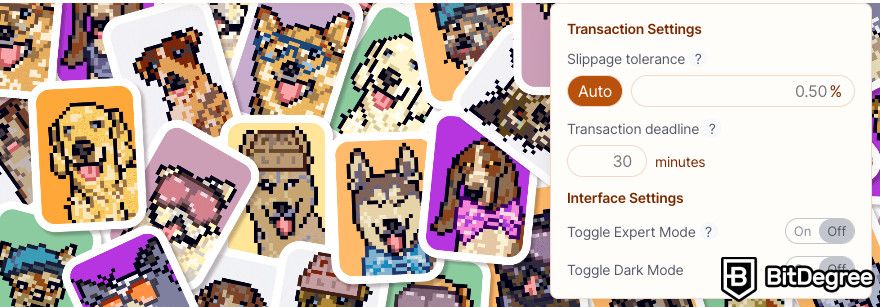
Bakeryswap is one of these platforms, offering unparalleled trading fees and fast transactions. The speed also helps to prevent slippage, which is the difference between the expected price of a transaction and its actual price upon execution. Bakeryswap allows users to set an acceptable slippage limit, automatically canceling transactions that exceed it.
That said, Ethereum does have its merits – after all, it’s the second most popular coin after Bitcoin. When Ethereum 2.0 launched two years ago, many users showed interest in ETH staking. Unfortunately, the minimum staking amount of 32 ETH was simply too large an investment for the average trader.
That’s when Binance came to the rescue by releasing BETH – a tokenized asset representing staked ETH on the Binance platform at a ratio of 1:1. Naturally, it’s meant to work on BSC, as well – something Bakeryswap didn’t waste any time capitalizing on, becoming one of the first DEXs on BSC to offer this token. That’s one perk of Bakeryswap staking reviews often forget to mention!

Did you know?
All Crypto Exchanges may look similar to you but they're NOT all the same!
Bakeryswap Review: CONS
This Bakeryswap review would be half-baked (pun intended!) if I only looked at the bright side, of course. The pros seem compelling enough – but what about the cons?
Limited Trading Options
One of the platform’s biggest drawbacks is its limited selection of cryptocurrencies and tokens, particularly those not based on the BSC. Bakeryswap offers over 50 cryptocurrencies, but popular options like Bitcoin and Ethereum are notably absent.
As mentioned earlier in this Bakeryswap review, the exchange does offer BETH (a BSC-based version of ETH) and BTCB, pegged to Bitcoin at a 1:1 ratio. However, many novice traders may not be familiar with these alternatives and might hesitate to switch to these less versatile options.
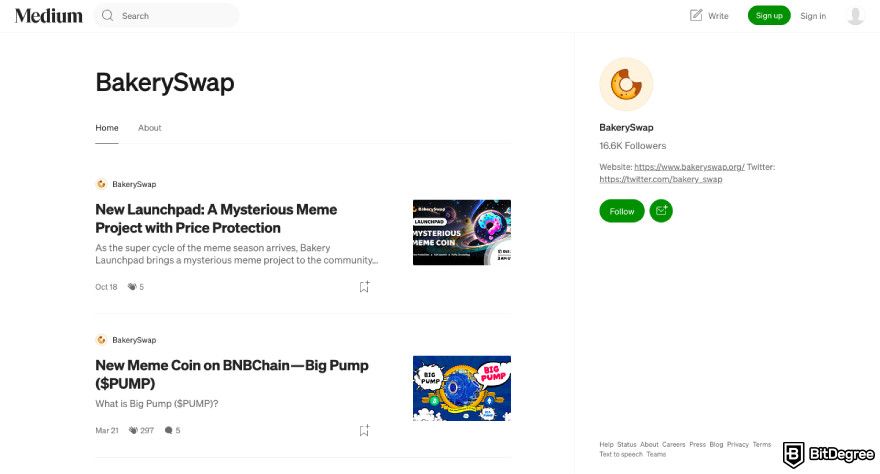
Bakeryswap doesn’t support fiat currency trading pairs, either. You won’t be able to directly exchange USD or any other fiat currency for crypto coins, only one crypto coin for another.
Needless to say, such a limited selection could deter many prospective users. However, to play devil’s advocate, users seeking more mainstream coins might be better served by one of the top centralized exchanges, such as Binance, Bybit, or Kraken.
Not Recommended for Beginners
User-friendliness is an immensely valuable trait for any platform. How many of us have encountered an app or website, only to turn away because figuring it out felt like too much hassle?
As you’ve probably guessed from the earlier parts of this Bakeryswap review, this platform might not be the preferred choice for those who’ve only just dipped their toes into the world of crypto. Some of it is simply due to the DEX aspect: decentralized exchanges are, by their very nature, less accessible to inexperienced users who aren’t well-versed in the intricacies of blockchain technology.
Still, Bakeryswap doesn’t seem interested in making it any easier. For one thing, the platform has no customer support at all, except for their X (formerly Twitter), Instagram and Telegram channels – quite unusual for any crypto exchange, decentralized or otherwise. The company doesn’t appear to be very active on social media; they only post sporadically, so it’s hard to estimate how quickly you’d get a response if you reached out to them on those channels asking for help.
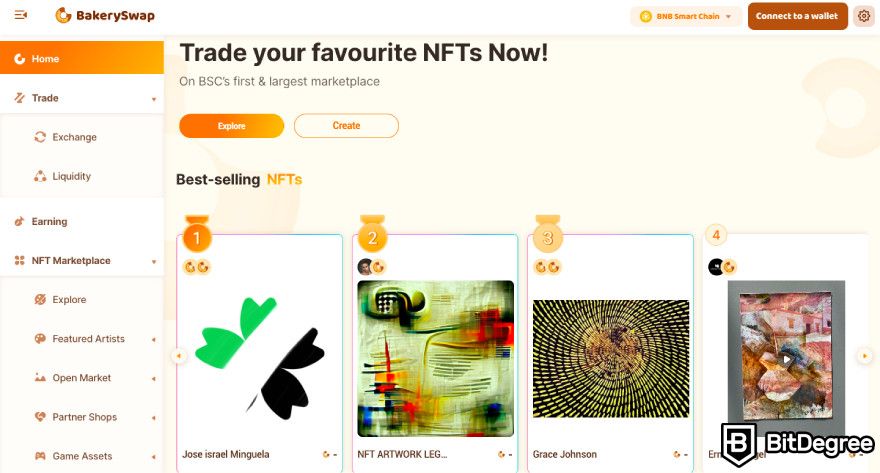
Bakeryswap’s website isn’t very informative, either – the most you get in terms of guidance are tooltips on certain buttons explaining what they do.
To make matters worse, as of this Bakeryswap review, the platform lacks mobile apps. Both Android and iOS users will need to rely on the web app. However, the website is fully optimized for mobile devices, and since DEXs are essentially P2P marketplaces that connect directly to your wallet, a separate phone app might not be necessary.
Not Available to US Residents
I’m going to wrap up this section with one final drawback that’s no doubt going to disappoint many readers of this Bakeryswap review: this platform is, sadly, only available in twenty countries, excluding Canada and the USA.
To explain the platform’s unavailability in the USA, Bakeryswap reviews often cite the SEC and their strict guidelines regarding foreign companies soliciting American investors. The increased anonymity of DEXs is also seen as a risk factor for illicit activities such as money laundering[2].
Whether the situation is likely to change anytime soon, it’s hard to say. To the best of my knowledge, the developers haven’t spoken up about any plans to branch out in the near future. At any rate, the exchange being decentralized means there’ll probably never be a “Bakeryswap USA”, in other words, a separate American branch.
Bakeryswap Fees
Hopefully, I’ve managed to give you a thorough overview so far! After you’ve digested the first part of this Bakeryswap review that gives you an idea of what Bakersywap is all about, we can move over to pricing.
As I noted before, the platform does boast a very competitive fee structure, thanks to the decentralization aspect and the additional cost-cutting perks of the Binance Smart Chain. As it’s not a centralized exchange like Binance, Bybit, or Kraken, Bakeryswap doesn’t employ the maker-taker model. Instead, it charges a flat transaction fee of 0.3%. 83% of the fee goes to liquidity providers as a reward, while the remainder is used to burn BAKE tokens in order to boost the token’s value over time.

Let me clarify that those fees are technically network fees, not transaction fees as such. The money is used to cover the mining costs, not as revenue for the exchange.
Deposits and withdrawals are managed directly through the users’ wallets. This means that Bakeryswap won’t charge you for getting your coins in or out of the platform – since, technically, they’re not stored on the platform to begin with, only in your wallet.
How to Use Bakeryswap?
If you’re ready to try out this exchange for yourself and see if it’s worth the hype, you better take some notes on this section of my Bakeryswap review!
Although, in all likelihood, you won’t have to – getting started with Bakeryswap is incredibly easy if you already have a crypto wallet. If not, I recommend Ledger Nano X or Trezor Safe 5 as safe and reliable options for beginners.
If you visit the official Bakeryswap website, you’ll notice there’s no “sign up” button: decentralized exchanges don’t have their own database, so there’s nothing to create an account for.
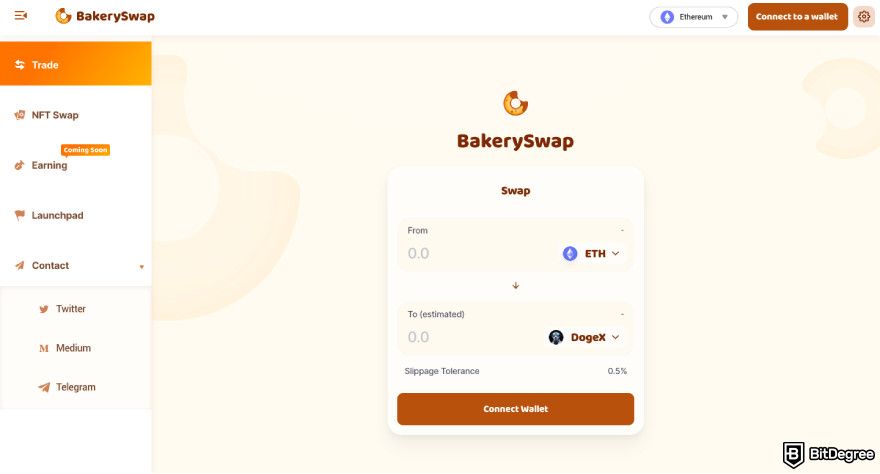
Instead, all you’ll have to do is connect your wallet, and you can get going!
Before you begin, make sure you have some BNB tokens in your wallet; since Bakeryswap runs on Binance Smart Chain, it uses BNB tokens for gas fees.
Step 1: Find a button that says “Connect to a wallet” and click on it.
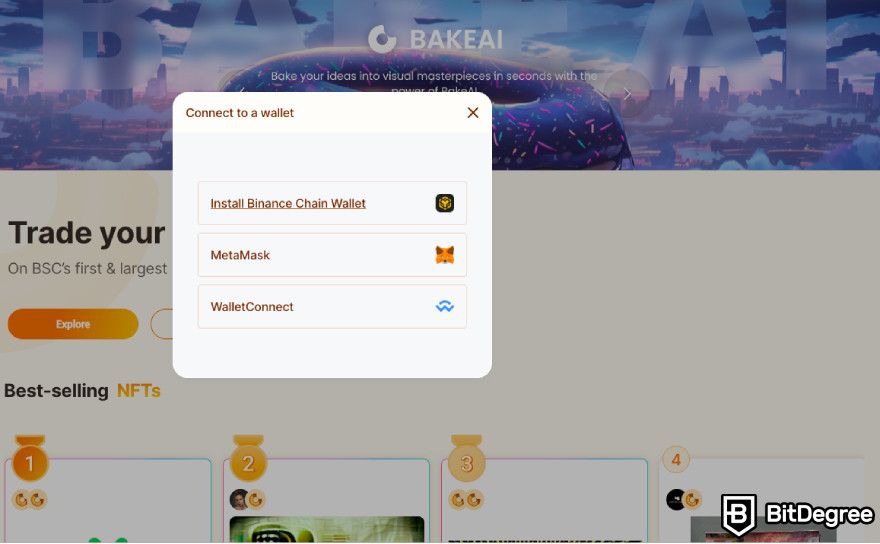
Step 2: You’ll be given a choice between two compatible wallets or, alternatively, an option to connect a third-party wallet.
Step 3: Complete the connection process.
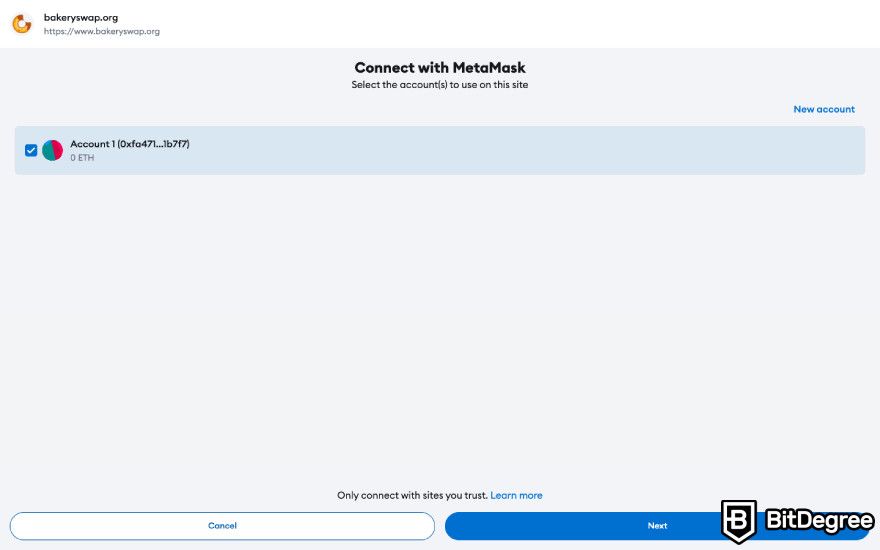
You’re all set up!

- Secure and reliable
- Accepts fiat currencies
- Lots of trading options
- Reputable exchange
- Accepts fiat currencies
- Offers various trading options

- Fiat currencies - accepted
- Simple to use
- Accepts only the most trustworthy cryptocurrencies
- A leading cryptocurrency exchange platform
- Best for beginner investors
- Accepts fiat currencies

- Beginner-friendly
- Secure
- Decent trading and withdrawal fees
Conclusions
Time to wrap up this Bakeryswap review with a little recap! Don’t let the cutesy name fool you – Bakeryswap is a powerful and fully-featured decentralized exchange that uses the AMM model. It’s hosted on the BSC network, thanks to which the users can enjoy cheap and speedy transactions. The platform also features an NFT marketplace.
Bakeryswap doesn't just let you swap one cryptocurrency for another – it gives you an opportunity to earn free tokens by either contributing your share to the liquidity pool or staking your tokens to have them generate some passive income for you! In addition to that, if you’ve got an artistic or entrepreneurial streak in you, feel free to place your own NFTs on the platform or crowdfund your crypto project using the Bakeryswap launchpad.
This is where its strengths end, however. The Bakeryswap’s scant cryptocurrency selection and near-total lack of customer support might be a turn-off for inexperienced traders who’d probably be better off choosing a centralized exchange, such as Binance, Bybit, or Kraken. Even though, according to the results of the latest Certik audit, Bakeryswap is safer than most other exchanges out there, there are still some concerns regarding the company’s lack of transparency.
The content published on this website is not aimed to give any kind of financial, investment, trading, or any other form of advice. BitDegree.org does not endorse or suggest you to buy, sell or hold any kind of cryptocurrency. Before making financial investment decisions, do consult your financial advisor.
Scientific References
1. J. Xu, K. Paruch, S. Cousaert, et al.: ‘SoK: Decentralized Exchanges (DEX) with Automated Market Maker (AMM) Protocols’;
2. S. Hägele: ‘Centralized exchanges vs. decentralized exchanges in cryptocurrency markets: A systematic literature review’.






